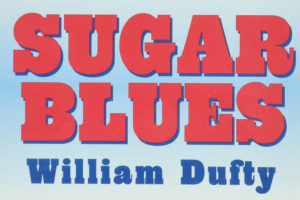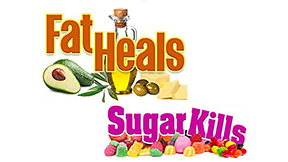Fat Heals—Sugar Kills: Chapter 5: A Weapon of Mass Destruction—Part 2
by Dr. Bruce Fife
Recap of Chapter 5, Part 1: A Weapon of Mass Destruction
Dr. Fife points out that sugar kills but does so slowly. It kills by accelerating the rate of aging and degeneration leading to chronic disease that causes disability and death. The high intake of sugar increases the risk of obesity, type 2 diabetes, high blood pressure, stroke, heart attack, senility, mental illness, liver disease, kidney disease, cancer, gallstones, arthritis, and dental cavities.
Studies have shown that around 60% of the foods eaten in America are ultra-processed convenience foods. The ultra-processed foods are those that have multiple ingredients and additives. These include flavorings, colorings, sweeteners, emulsifiers, preservatives, and many others. The problem with these ultra-processed foods is that around 30% of the calories come from sugar.
Dr. Fife points out that Vitamin C is just one of the many essential nutrients that is deficient in a diet overloaded with sugar-laden processed foods. He again references the concept of sub-clinical malnutrition, a condition that can remain unnoticed indefinitely.
Dr. Fife discusses the connection between elevated blood levels of homocysteine and heart disease.
Chapter 5: A Weapon of Mass Destruction—Part 2
Obesity
Dr. Fife points out the difficulties that people had in keeping their weight off after being on a low-fat diet.
Low-fat, calorie restricted diets are doomed to fail because they are based on the erroneous belief that all calories are alike, regardless of their source…this belief tends to single out fat because it contains more than twice as many calories as either carbohydrates or protein.
Fife continues by saying that fat has been targeted as a villain and eating too much fat has been blamed on causing the obesity epidemic. He suggests that this notion is wrong because the percent of fat consumed in our diets has decreased, but obesity has increased.
He points out that overweight people are those that trim off fat from their meat, consume non-fat dairy, etc. Slim people gorge on fatty foods.
Those people that have a history of weight problems are more likely than normal-weight individuals to eat low-fat foods.
My Comments: Overweight people are also those that consume more artificially sweetened beverages using aspartame or sucralose (Splenda) compared to normal weight people. The overweight people also tend to be caught up in the “calorie-counting” squirrel cage and engaged in fad diets.
Low-fat Diet Problem
Continuing: Key point: Most of the fat in your body comes from consumed carbohydrates and NOT fat! If a so-called low-fat diet has less fat, then the calories are replaced with….yes, roll the drums…more carbohydrates! Thus, a low-fat diet is really a high-carb diet. Worse yet, those carbs tend to be sugar, high fructose corn syrup, and refined flours. All low-fat diets are doomed from the start.
Why do these diets fail from the start? The problem is glucose. Carbohydrates are converted into glucose and released into your blood stream. Excess blood glucose levels trigger the release of insulin into your bloodstream.
Insulin not only shuttles glucose into the cells, but it also triggers the conversion of glucose into fat and shuttles fat into the fat cells. Insulin is a fat-storage hormone. The more insulin you have coursing through your veins, the more fat is produced and deposited in your fat cells, and the more weight you gain.
My Comments: Let’s digest what Dr. Fife just said. Excess carbs trigger insulin, and the insulin converts those carbs into fat. You end up buttering your body with excess fat just as if you would slog heaps of butter on your toast.
Nathan Pritikin was partially successful with his low-fat diet regimen because he also eliminated all refined carbohydrates. Unfortunately, he didn’t understand the importance of adequate amounts of healthy fats in one’s diet.
Continuing:
Protein and fat have little to no effect on blood glucose levels. Consequently, fat and protein do not stimulate much of an insulin response and do not promote weight gain.
The “too much carbohydrate problem” is compounded when the carbs are sugars and refined starch. The refined starches are white flour, white rice, etc. Fake “whole wheat” breads are still made from mostly white flour.
Those refined carbs promote insulin resistance. Now your body is programmed to store fat, but it gets worse. The insulin resistance also tells your body not to release stored fat. The excess carbs in your diet not only make you fat, it makes sure you stay fat.
My Comments: I hope you can see the folly of the food industry’s peddling of “diet” foods. This has to be one of the worst frauds perpetrated on the American public. It’s whole foods, real foods, and healthy fats that will help you to maintain a normal body weight, and not ultra-processed garbage from the food industry.
Continuing: Dr. Fife stresses that being overweight isn’t just about your weight or how you look. Being overweight profoundly affects your health.
Nearly 70% of the diagnosed cases of heart disease are related to obesity. The risk of death rises with increasing weight. Even moderate weight excess (10 to 20 pounds for a person of average height) increases the risk of death, particularly among adults between the ages of 30 and 64.
Excess body weight contributes to other risk factors. High blood pressure is twice as common in obese adults compared to those of normal weight. Obesity is associated with elevated fat levels and decreased HDL (good cholesterol) levels.
A weight gain of only 11-18 pounds doubles a person’s risk of developing type 2 diabetes. Insulin resistance and hyperinsulinemia (high insulin levels) which are conditions associated with diabetes, increase with weight. Over 80% of the people with type 2 diabetes are overweight or obese.
My Comments: It’s no wonder that we have an epidemic of type 2 diabetes in the US. Forget about Covid; the type 2 diabetes problem is far worse, but it garners little or no headlines.
Even more alarming is that people that have type 2 diabetes are ones that have been affected the most from Covid. The type 2 diabetics fatality rate is far higher, and their symptoms are far worse compared to those that do not have type 2 diabetes.
When you add in other co-morbidity factors such as high blood pressure and heart disease, your immunity is trashed, and your body will be more challenged to fight off disease.
Continuing: Obesity is an independent risk factor for heart disease affecting both men and women.
Obesity is a major health problem, and the primary cause is the overconsumption of sugars and refined starch.
NEURODEGENERATION: THE NEW DIABETES
Sugar Doesn’t Make Memories Sweeter
There’s another benefit of reducing your sugar consumption; it’s better memory.
Excess sugar consumption can keep you from remembering what day it is, where you live, or the name of your spouse.
Mr. Comment: One problem I see with Dr. Fife’s text is just what is sugar overconsumption? Many people cut down only to go from horrible to not as bad, but it’s still bad.
There’s virtually unanimous agreement that smoking is really bad for your health. Is cutting down from a two-pack a day habit to one-pack per day an improvement? Yes, it‘s an improvement, but wouldn’t it be much better to totally cease smoking altogether?
For many people, cutting down on sugar consumption is like going from the two-pack per day smoker to a one-pack per day smoker. You’re still an addicted user to sugar as the smoker is addicted to nicotine.
If the cutting down on smoking is a weaning off process that leads to permanent cessation, then that’s an entirely different matter. The same holds true for the sugar addict.
Just one 12 ounce can of soda pop has about 10 teaspoons of sugar, which is still, way, way too much to break your sugar addiction. Oh, you’ll drink the “diet” stuff instead. Ask yourself, why are overweight people the largest consumers of artificial sweeteners?
My personal experience suggests that the closer you can get your refined carbohydrates (sugar, HFCS, refined flour, rice, etc.) to zero, the better off you will be.
Most reformed alcoholics well know that the best way to stay permanently dry is to do exactly that; they do not consume alcohol, period! They know what can happen with just one drink!
Continuing: Dr. Fife suggests that the overconsumption of sugary food and drinks can lead to Alzheimer’s disease. It is insulin resistance that is the problem. He quotes mice studies that show that sugar-fed mice showed the presence of Alzheimer’s-like plaque deposits whereas the non-sugar-fed mice did not. Additionally, Dr. Fife states that there is evidence linking overconsumption of sugar to Parkinson’s disease.
Insulin Resistance and the Brain
Studies show that people with diabetes have a smaller brain size compared to those that do not have diabetes. This is due to the death of brain cells in diabetics. The brains of people with diabetes age pre-maturely.
One researcher showed that the brains of diabetics are about ten years older compared to non-diabetics. Even pre-diabetics are in danger of developing Alzheimer’s. The common denominator between pre-diabetic, diabetics and Alzheimer’s is insulin resistance.
Insulin levels also play a role in normal brain functioning. Dr. Fife adds that Alzheimer’s is now considered to be type 3 diabetes.
Other neurological disorders such as vascular dementia, Parkinson’s disease, Huntington’s disease, and ALS, also exhibit features suggesting insulin resistance as either an important underlying factor or as a contributing factor to the initiation and progression of these diseases. All of the major neurodegenerative diseases display a marked decline in energy metabolism leading to cell death and loss of brain volume.
Insulin resistance exacerbates the severity of the symptoms and reduces the therapeutic efficacy of drug therapy.
Dr. Fife also notes the connection between ALS (Lou Gehrig’s disease) and insulin resistance. He also mentions that Huntington’s disease, which is primarily inherited, also appears to be influenced by insulin resistance.
Here is what is scaringly sobering:
The changes that take place in the body that lead to diabetes and eventually to neurodegeneration occur long before these diseases become apparent. Glucose metabolism becomes abnormal one to two decades before type 2 diabetes is diagnosed. Neurogenerative diseases may surface another two decades after that.
Eighty percent of your brain tissues may already be damaged before you’re diagnosed! Dr. Fife concludes the section by stating the following:
If you are having memory or cognitive problems or feel that you are losing your mind due to neurodegeneration, you likely have sugar to thank for it.
My Comments: If you are the average American whose food is 60% ultra-processed, you are substantially increasing your chances of having severe cognitive decline later in life. The problem is that the damage may become manifest decades later after years of dietary abuse.
The connection inevitably becomes lost. John Doe at 75 doesn’t realize that his Parkinson’s disease started in his 20s, 30s, and 40s as he consumed his sugary foods and drinks. He liked his junk food, and his doctor didn’t seem to be overly concerned that John was thirty pounds overweight.
When John was diagnosed with pre-diabetes at 65, his doctor, rather than reading John the riot act, put him on metformin. It just ran downhill after that. Later, his doctor added a statin drug and blood pressure meds. Neither the patient nor the doctor had any inkling of the cause and effect of the cascade of events in John’s life.
Next, we’ll continue with Part 3 of this chapter. The lead-off section will be eye health End.
 Note: We have republished this book review and digest with updated comments. You might enjoy reading Sugar Blues in its entirety. To order, please
Note: We have republished this book review and digest with updated comments. You might enjoy reading Sugar Blues in its entirety. To order, please  Fat Heals—Sugar Kills: Book by Dr. Druce Fife
Fat Heals—Sugar Kills: Book by Dr. Druce Fife The Deductible
The Deductible by Lance & Isaac Reedy
by Lance & Isaac Reedy The fall Annual Election Period (also know as Medicare open enrollment) is upon us. We have started discussing 2022 plans as of October 1st. We can start taking applications October 15th for the 2022 plan year. December 7 is the closing date of the AEP.
The fall Annual Election Period (also know as Medicare open enrollment) is upon us. We have started discussing 2022 plans as of October 1st. We can start taking applications October 15th for the 2022 plan year. December 7 is the closing date of the AEP.